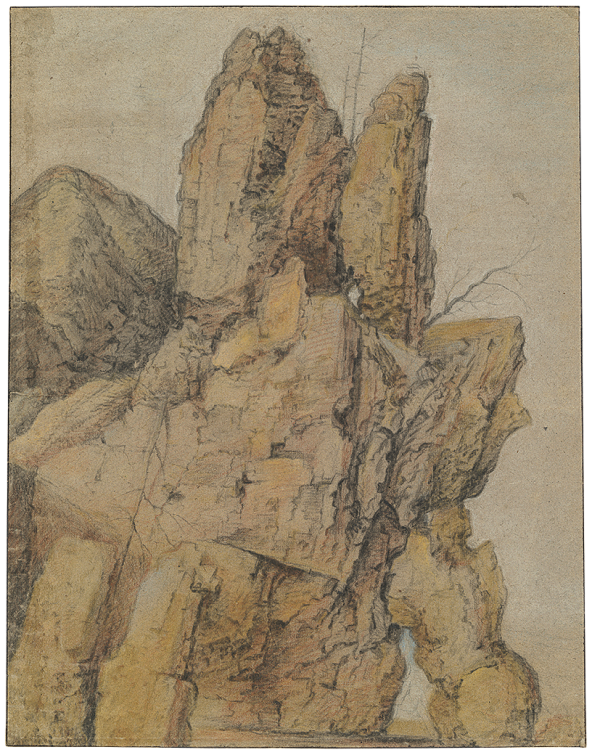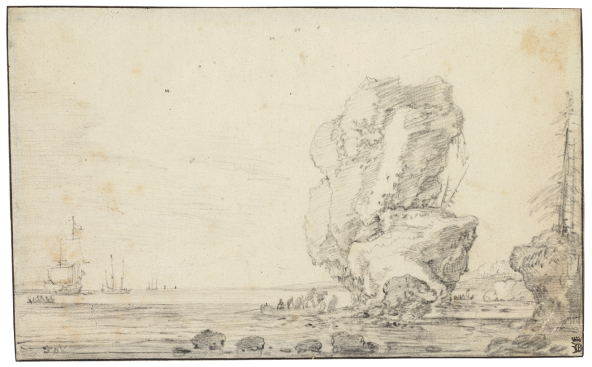Choose a background colour
Allaert van Everdingen, Dutch, 1621-1675: Rocky Coast with Boats on a Rough Sea, c. 1650
Brush and pen in brown ink and brown wash over traces of black chalk on paper; framing lines in brown ink.
4 1⁄2 × 6 1⁄2 in. (11.5 × 16.5 cm)
Recto, on rock lower center, signed by the artist with monogram, in pen and brown ink, AVE; verso, lower right, in pencil (nineteenth or twentieth century), A drawing by Everdingen.
- Chain Lines:
- Vertical, 25 – 26 mm.
- Watermark:
- Probably a Coat-of-Arms (unidentified), minor fragment showing the crown on top.
- Provenance:
Sybrand Feitama Jr., 1694 – 1758, Amsterdam, purchased between 1710 and 1712 (in his Notes on Drawings, 441: I Zee met een klip; alle 8 met roet motr: Ao 1670 geteekend; … en de zes overige zyn gekocht in, in sedert het jaar 1710 tot 1712, à f 4:- ‘t stuck; is dus f 36,-,-.); his sale, De Bosch, Amsterdam, 16 October 1758, no. K27 (Een rotsig strandje, met roet, omtrent Ao. 1670. H. 4½, br. 6¼ d.; sold f 13,-, to P. Kalkoen Wmsz.); Pieter Willemsz. Calkoen, 1712 – 1780, Amsterdam; his sale, Van der Schley et al., Amsterdam, 10 September 1781, no. E374 (Een Zeestrand met een woelende Zee, gestoffeerd met twee Visschers Schuiten, en op het strand eenigen Visschers, met roet gewassen; sold f 11,15, to Nijman); Jan Danser Nijman, 1735 – 1795, The Hague or Amsterdam; his sale, Van der Schley et al., Amsterdam, 19 March 1798, no. G10 (Een Noords Strandgezicht, in Zee eenige Scheepen en op ‘t Strand eenige Beeldjes; met roet gewassen; sold f 8,15); Henri Duval, Liège; his sale, Frederik Muller, Amsterdam, 22 – 23 June 1910, lot 115; Henry Oppenheimer, 1859 – 1932, London (Lugt 1351); his sale, Christie’s, London, 13 July 1936, lot 243b; Ernst Goldschmidt, Brussels; sale, Tajan, Paris, 28 October 1994, lot 13; Sheldon and Leena Peck, Boston (Lugt 3847); gift to the Ackland Art Museum, inv. no. 2017.1.32.
- Literature/Exhibitions:
F. Robinson in Chapel Hill, Ithaca & Worcester 1999 – 2001, 52 – 53, no. 9; Davies 2007, 283, no. 283; E. Dullaart in Alkmaar 2021, 106, fig. 146.
- Ackland Catalogue:
- 2017.1.32
Allart van Everdingen traveled to Scandinavia, likely early in his career around 1644, and drew views in Norway and Sweden. Variations of his Nordic scenes featured prominently in the drawings, etchings, and paintings that he completed after his return. This sheet, although topographically like the North Sea, is more likely a studio-generated composition created from the artist’s mind. As rough seas challenge the fishermen in their boats, figures on shore watch calmly and perform their duties, presenting a curious liminal moment where the day could either conclude safely or end in disaster.
One of the enduring legends about Allaert van Everdingen, coming from Arnold Houbraken (1660 – 1719), is that a dangerous storm he experienced on a trip to the Baltic Sea landed him “willing or not” on the coast of Norway.1
The event was perhaps not quite the “shipwreck” reiterated by later commentators, but the story nevertheless served as the central piece of biographical drama, and perhaps even as a bit of self-fashioning by the artist himself, for he is now hailed as the first painter of the Scandinavian landscape.2
That he actually visited Nordic countries seems beyond doubt.3
His drawings clearly show places such as Risør in Norway, then an important Dutch trading port for timber; as well as Trollhätten and Mölndal in Sweden, where he witnessed and drew some of the region’s more dramatic waterfalls. He probably made the trip early in his career, around 1644.4
Back in the Netherlands, Van Everdingen spent the rest of his career designing variations of his Nordic-inspired scenery in his paintings, drawings, and etchings. Imposing rocky outcrops with an almost surreal monolithic character, such as the one featured in the present work, appear in many of his landscapes, whether coastal or set more inland.5
They might at first glance appear to be topographically Scandinavian in essence, and it is true that Van Everdingen likely encountered a number of similar coasts during his voyage around the North Sea. As much or more weight should be given, however, to an artistic tradition he inherited from a previous generation of artists, such as his first teacher Roelant Savery (1576 – 1639), who had also taken a great interest in exotic rock formations, though inspired by his travels in Bohemia and the Alps rather than any coastal location Fig. 47.1.6

Roelant Savery, Rock Outcrop, 1606 – 07. Black, white, and red chalk, pastels in ocher and blue, on gray-brown paper, 441 × 346 mm. Hamburg, Hamburger Kunsthalle, inv. no. 22488.
bpk Bildagentur/Hamburger Kunsthalle/Christoph Irrgang/Art Resource, NY
Other artists such as Simon de Vlieger (1600 – 1653) would freely invent similar coastal monoliths despite having never seen such formations in person as far as we know Fig. 47.2.7

Simon de Vlieger, Coastal Scene with Rock Formation, before 1653. Black chalk and gray wash over graphite on paper, 191 × 307 mm. Cambridge, Fitzwilliam Museum, inv. no. PD.864 – 1963.
The Fitzwilliam Museum, Cambridge
Van Everdingen’s travels informed and refi ned his own distinctive landscape style, but despite whatever topographic literalness he employed on occasion, the stronger impulse was to imaginatively craft landscape motifs in the mode of what Joaneath Spicer called the “pictorial vocabulary of otherness.” 8
The present work gives every appearance of being a studio-generated composition made wholly from the imagination despite the artist’s intention to impart a Nordic character to the coast.
The rough seas battled by the fishermen in their boats here seem more the result of a strong gale than a true storm. The figures on the shore go about their business or watch calmly as the fishermen contend with a strong leeward wind that appears to threaten their safety, or at least proves a challenge to handle. In his study of Dutch tempest and shipwreck imagery, Lawrence Goedde offered a range of metaphoric interpretations for this sort of intermediate level of turmoil, in which we are confronted with neither complete disaster nor calm seas but rather a “threatening lee shore,” a reminder, for example, that the dangers of life are ever-present.9
It is difficult to say if Van Everdingen intended anything other than an intensified image of fishermen handling one of the normal challenges of their profession, or perhaps that the foreign-seeming locale offered up additional challenges.
Van Everdingen’s drawn oeuvre, while vast, has long resisted the development of a chronological framework based on style or other factors, a problem exacerbated by the fact that he almost never dated his drawings, and rarely his paintings.10
Most of Van Everdingen’s marine paintings are early works, but drawings with marine subjects occupied him throughout his career.11
The Peck drawing might well be a later work from around 1670, as suggested in the notes of its earliest known owner, Sybrand Feitama (who acquired it between 1710 and 1712), though his reasons for assigning it this date are unknown.
End Notes
Houbraken 1718 – 21, vol. 2, 95 – 96.
Blanc 2016, 15.
For the evidence and its historiography, see Davies 1978, 17 – 27; Davies 2001, 26 – 27, and Alkmaar 2021. See also Sidén 2012 for an overview of Van Everdingen’s activities in Sweden, including the Trip commission.
See Davies 2007, 11. The year 1644 appears on a copy by Jan de Beijer (1703 – 1780) of one of Van Everdingen’s drawings of Risør, Norway, providing the only date that can be linked to the trip.
While his frequent reuse of the motif makes a comprehensive listing of drawings unwieldy, for some fairly dramatic examples, see Davies 2007, no. 8 (Haarlem, Teylers Museum; see Plomp 1997, no. 140); no. 112 (Vienna, Albertina; see New York & Fort Worth 1995, no. 71); and no. 159 (Cleveland, Cleveland Museum of Art; see Glaubinger 1982).
For Savery’s interest in rock formations, see Spicer 1997, 28 – 31. It also appears that Van Everdingen owned some of Savery’s Tyrolean landscape drawings and even reworked them; see Davies 2001, 78 – 80, 84 – 85; and Davies 2001, 12. For further discussion of Van Everdingen’s rock motifs, see Glaubinger 1982.
For De Vlieger’s rocky coastal landscapes, and Savery’s impact, see Van Eeghen 2011, 210 – 12.
Spicer 1997.
Goedde 1989, 180 – 85. Goedde also shows how prevalent the motif of a ship approaching threatening rocks was in the emblem tradition (idem, 183 – 85) in the seventeenth and early eighteenth centuries. For Goedde’s ideas in relation to Van Everdingen’s seascape paintings, see Davies 2013, 96 – 97.
For this problem, see Davies 2007, 10 – 11, 36 – 47.
Davies 1978, 75.
